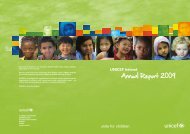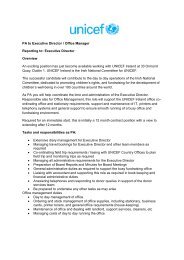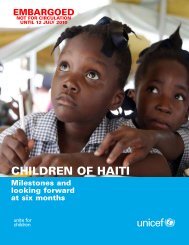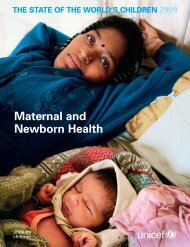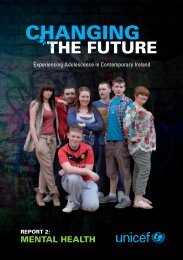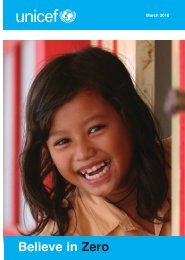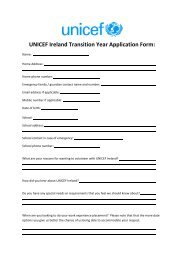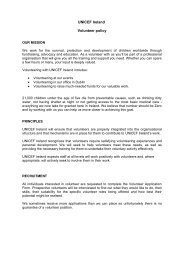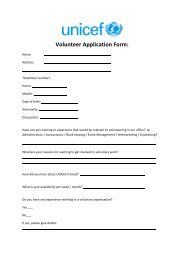Humanitarian Action for Children 2011 - Unicef
Humanitarian Action for Children 2011 - Unicef
Humanitarian Action for Children 2011 - Unicef
- No tags were found...
You also want an ePaper? Increase the reach of your titles
YUMPU automatically turns print PDFs into web optimized ePapers that Google loves.
agility is especially urgent in the face of climatechange. According to the National Oceanicand Atmospheric Administration (NOAA),2010 was tied with 2005 as the warmest yearon record and saw a spate of extreme climateevents in all continents. 20 Climate-related hazardsare increasing, accounting <strong>for</strong> 70 per centof all disasters today compared to 50 per centUsing resilience as a guiding principlecan offer the humanitarian communityuseful insight into priority areasrequiring improvement.two decades ago, 21 and such climate-relatedcrises are projected to affect hundreds of millionsevery year as early as 2015. 22 A confluenceof social and economic factors, such asunplanned urbanization and environmentaldegradation, is at work in determining theimpact of climate-related disasters. Broadertrends clearly point in the direction of moreextreme global weather conditions in thefuture, which will have a disproportionateadverse impact on the poorest.The enormity of this challenge must beaddres sed with investments that manageclimate-related risks so that entire populationscan benefit. Disaster risk reduction,with com munity resilience as an objective,is increasingly recognized as a key climatechangeadaptation strategy. Ef<strong>for</strong>ts to build onlocal capacities of disaster-prone and disasteraffectedcommunities must be redoubled as thelarger humanitarian system also better equipsitself <strong>for</strong> a future of greater risk, uncertaintyand demand.The way <strong>for</strong>wardSix years after the Indian Ocean tsunami,the scale and scope of which challengedevery aspect of humanitarian response, thehumanitarian community confronts anotherimportant watershed in its evolution. Discussionsare under way to take a fresh look at itscurrent business model. Using resilience as aguiding principle can offer the humanitariancommunity useful insight into priority areasrequiring improvement. These areas includethe following:• Partnership – Building resilience is amulti-stakeholder endeavour. <strong>Humanitarian</strong>or ga nizations must seek creative andcontext-specific alliances, ranging from theprivate sector to community developmentorganizations.• Innovation – <strong>Humanitarian</strong> organizationsmust deliberately foster experimentationand diffusion of promising institutionaland technological solutions.• Risk management – <strong>Humanitarian</strong> organizationsneed continually to better understandand analyse high-risk operatingenvironments in order to find programmeopportunities and access populations. Riskmanagement should enable and not justcontrol.• Fundamentals – Accountability, participation,capacity development and localand national ownership continue to beessential <strong>for</strong> effectively supporting a communityin crisis to build a path to sustainablerecovery.• Social trans<strong>for</strong>mation – Resilience isachiev ed through social processes whoseoutcomes defy precise measurement. Toencourage investments by donor anddeveloping countries that are truly sustainable,donors should review and revisetheir own per<strong>for</strong>mance monitoring andreporting systems.Achieving progress in these domains willhelp foster a humanitarian system that ispredictable, timely and effective. This progressmust be predicated on a stronger recognitionof the relationship between humanitarianand development programming, and theimportance of supporting national and localactors to manage increasing uncertaintyand risk. In so doing, the humanitariancommunity works towards the resilience ofboth the humanitarian system and the countriesand communities we are committed to serving.6 <strong>2011</strong> UNICEF <strong>Humanitarian</strong> <strong>Action</strong> FOR CHILDREN | www.unicef.org/hac<strong>2011</strong>




